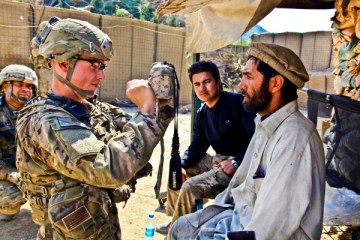An airman helps drop supplies out the rear of his C-17 to allies far below at an undisclosed location in Afghanistan last month because IEDs make ground delivery too dangerous.
It’s becoming increasingly clear that Afghanistan is like a giant checkerboard, and U.S. and NATO troops are the checkers, limited to the black squares.
After more than a decade of war combined with a hearts-and-minds campaign designed to win over the locals, it’s disturbing to see the U.S. Army contracting for what it terms “Consequence Management…Over and Above Services to Support Non-Intrusive Inspection (NII) Systems.”
What’s that? Well, according to Army contracting documents, it’s a contract for added maintenance of “Vehicle and Cargo Inspection Systems (VACIS), Military Mobile VACIS (MMV), Relocatable VACIS (RVACIS), Mobile VACIS (MVACIS), and Railroad VACIS located in Southwest Asia.”
They’re needed “to help protect U.S. and Coalition Forces from imminent threats from Improved Explosive Devices (IEDs) and other concealed weapons being used in southwest Asia,” the Army says. It lists “Afghanistan, Iraq, Kuwait, Qatar and Uzbekistan” as the nations where 107 such systems needing beyond-normal maintenance are based.
The Army plans on spending up to $4.8 million on such exceptional maintenance for these systems over the coming year.
Contracting aside: the Army plans to award the deal to SAIC on a sole-source basis, even though they are commercial sensors.
“Notwithstanding their commercial nature and availability, these non-intrusive inspection systems are highly technical and complex,” the Army argues in its justification for the sole-source award. “Utilization of any nonstandard parts or maintenance performed by non-certified personnel would endanger current warranty provisions and risk system operability.”
Still think competition is a good idea? Sorry: “Because the NRC [Nuclear Regulatory Commission] license allows only specific licensees to service the system and SAIC has not licensed any other entity, there is no competition.”
What if the U.S. government wanted to do the work itself? “SAIC is not willing to sell or license its proprietary information to the U.S. government for any amount,” SAIC told the government earlier this year.
You could say SAIC has the U.S. government over a barrel. Of dynamite.
Anyway, back to the issue at hand. Obviously, the U.S. and its allies must have the best technology to protect their troops in a combat zone. But there is a disquieting theme to much that is happening in Afghanistan and environs: after a decade, we remain in a cowering defensive crouch.

ARMY PHOTO / SGT. TREY HARVEY
The allies frisk the bodies and scan the irises of local citizens to be sure they’re not bad guys. They’ve been increasingly airdropping vital supplies to their soldiers because the roads are too dangerous to drive. This latest contract shows the extent to which they’re scanning the region’s infrastructure looking for bombs.
“Being in Afghanistan, every day throws up a different challenge, and the enemy is nothing if not innovative and committed,” Australian Army Brigadier General Roger Noble told reporters at the Pentagon Wednesday via a teleconference from Kabul. “We’ll leave no stone unturned to try and keep our people safe. We’re not going to shy away from our commitment to be successful in the campaign.”
Perhaps. But that such widespread defensive actions are happening after a decade of war is not a good sign for today, and an even grimmer omen for tomorrow.


